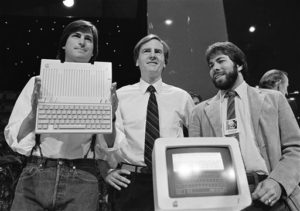By Joel Neuschwander
Unlike the founders of most major tech companies, the genius behind Apple didn’t attend a prestigious university. In fact, he didn’t even graduate from college. Steve Jobs founded one of the world’s largest technology companies out of his family garage.
Beginnings
Steve Jobs founded Apple in 1976 with Steve Wozniak and Ronald Wayne. But that’s far from where his story begins.
Jobs was born on February 24th, 1955 in San Francisco where he was given up for adoption by his biological parents, Joanne Schieble and Abdulfattah Jandali, two University of Wisconsin graduate students. He was adopted shortly after by Clara Jobs, an accountant, and Paul Jobs, a Coast Guard Veteran.
Jobs grew up in Mountain View, California, an area that would later become known as Silicon Valley. According to “Steve Jobs” on Biography.com, Jobs developed an interest in technology at a young age, “As a boy, Jobs and his father worked on electronics in the family garage. Paul showed his son how to take apart and reconstruct electronics, a hobby which instilled confidence, tenacity, and mechanical prowess in the young Jobs.”
In grade school, Jobs was easily distracted and bored, leading to him often pulling pranks on classmates and teachers. His fourth grade teacher needed to bribe him to study. Despite this, he was regarded as an intelligent and innovative thinker. With this in mind, many of his teachers wanted him to skip ahead to high school. His parents, however, declined the offer.

Jobs attended Homestead High School, where he met friend and future partner Steve Wozniak, who was attending the University of California at the time. In a 2007 interview with ABC News, Wozniak recounted how he and Jobs first met. Wozniak said in the interview, “We first met in 1971 during my college years, while he was in high school. A friend said, ‘You should meet Steve Jobs, because he likes electronics and he also plays pranks.’ So he introduced us.”
After high school, Jobs went to Reed College, in Portland, Oregon, but dropped out after six months. In his 2005 commencement speech at Stanford, Jobs explained why. “I naively chose a college that was almost as expensive as Stanford, and all of my working-class parents’ savings were being spent on my college tuition. After six months, I couldn’t see the value in it. I had no idea what I wanted to do with my life and no idea how college was going to help me figure it out.”
Nonetheless, he was still able to “drop in” on the classes he wanted to take, without having to take the required classes. He was not able to stay in a dorm, so instead he slept on the floor of his friend’s room.
Jobs’s favorite class that he dropped in on, as stated in the speech, was Calligraphy. Reed College, at the time, was believed to have the best calligraphy institution in the country. He was inspired to join this class because of the artwork around the school. From this class, Jobs applied techniques he had learned to designing the first Macintosh computer.
That class was the only one Jobs dropped in on, and turns out, it did make a difference. If Jobs hadn’t taken that calligraphy class, the original Macintosh wouldn’t have had the many different styles of font it did. Jobs said, “since Windows just copied the Mac, it’s likely that no personal computer would have them.”
Steve Jobs: Atari Employee
Following his 18-month journey of dropping in on classes, Jobs moved back home to California and took a job with the video game company Atari as a technician. It wasn’t all good though. Atari co-founder Nolan Bushnell remembers young Jobs as a “brilliant, curious and aggressive young man, though very abrasive as well.”
Jobs also made several enemies at the company by openly mocking them, according to an article on gamasutra.com. In spite of these flaws, Jobs managed to stick around. The article Steve Jobs Atari Employee says, “Despite this, he was a promising employee, so Atari found a way to keep him on board.”
Jobs worked the night shift at the company, and occasionally invited future partner Steve Wozniak to help him with engineering challenges.
It was six months later that Jobs was on the verge of quitting his job at Atari. At that same time, the company had found success with the game Breakout. However, they were experiencing problems with the game in Germany and needed someone to fix it. Jobs, who was about to leave for India to conduct “spiritual research,” volunteered to fly to Germany from India.
It is mostly unclear as to what happened on that trip, but Bushnell knew. In an interview with GDC Online, he stated, “Atari actually paid his way to India, where he spent a few months seeing the light, and actually got a blood disease.”
The Starting of a Giant

Believe it or not, Apple almost didn’t happen. When Jobs and Steve Wozniak first met, Wozniak had created the first computer with a typewriter-like keyboard. This would later be known as the ‘Apple I’. But Wozniak wasn’t trying to change the world in any way. According to a Wozniak statement on macworld.com, “It was to really show the people around me, to boast, to be clever, to get acknowledgement for having designed a very inexpensive computer.”
Wozniak nearly backed out, saying, “‘I was shy and felt that I knew little about the newest developments in computers.” But Jobs saw the computer, and recognized its potential.
Sacrifices were made to earn enough money to fund its production. Jobs sold his Volkswagen van, and Wozniak sold his HP calculator.
Their dreams were realized on April 1, 1976. Jobs and Wozniak, along with Ronald Wayne, founded Apple out of Jobs’s garage in Cupertino, California. Wozniak, in a 1984 interview with Byte Magazine, credits Jobs with the idea for the name. He said, “I thought that it might be because there were apples in the orchard or maybe just its fruitarian nature. Maybe the word just happened to occur to him. In any case, we both tried to come up with better names but neither one of us could think of anything better after Apple was mentioned.”

With the foundation of the company laid, it was time to get to work. Wozniak hand built the first 50 models of the Apple I and didn’t want to sell them for much more than the costs of the parts. Jobs, however, wanted to pitch the product to several stores, in hope that one would sell it. After several failed attempts, the group finally got their retailer: The Byte Shop in Mountain View, California, the area where Jobs grew up. The 50 computers were sold at the shop for $500 each.
Eventually, the risk of having to earn enough money to offset the cost of the parts is what led Ronald Wayne to leave the company. Wayne said in a 2013 interview with NextShark, “Jobs and Woz didn’t have two nickels to rub together. If this thing blew up, how was that… going to be repaid? Did they have the money? No. Was I reachable? Yes.”
The Apple I earned the corporation around $774,000, according to Biography.com. Only 200 computers were ever made, making them collector’s items.
After the resounding success of the Apple I, Jobs and Apple released the Apple II in April 1977. The Apple II was known for the first app on a computer: Visicalc, a calculator that drove sales through the roof. The computer was also the first to have color graphics.
Decline and firing of Jobs
Through the next several years Apple stayed important in the computer industry, including releasing the first Macintosh in 1984. But in the early 1980’s, they were surpassed by their biggest rival, IBM, in sales.
Then, a year later, the unthinkable happened. Jobs was fired from the company he helped start. In that 2005 commencement speech, he explained why. Jobs said, “As Apple grew we hired someone who I thought was very talented to run the company with me, and for the first year or so things went well. But then our visions of the future began to diverge and eventually we had a falling out. When we did, our Board of Directors sided with him. So at 30 I was out.”
In 1986, Jobs purchased an animation company from George Lucas, which later became known as Pixar. In addition to that, Jobs started a new hardware and software company called NeXT Inc.
NeXT did not have nearly as much success as hoped with only 50,000 total computers shipped in the 12 years of the company’s history.
Return to Apple and advancements
In the winter of 1996, Apple was in the midst of its worst plunge ever. The company failed to make a profit at all and posted a $68 million loss for that quarter. Losing ground to Microsoft, Apple needed a spark.
In December 1996, Apple got exactly what they were looking for. Steve Jobs returned. Apple also bought Jobs’s company NeXT and incorporated much of its software into Apple’s next products.
Declining health
Jobs’s often-hyped branding campaigns put Apple back on the map in the early 2000s but in 2003, Jobs was about to receive news that would change his life.
He discovered a neuroendocrine tumor on his pancreas, a rare but treatable form of cancer. Doctors wanted to remove it immediately with surgery but Jobs waited 9 months to undergo the surgery. This left Apple’s executives in fear that shareholders would pull their stock if they found out the CEO was ill.
In 2004, Jobs finally had a successful surgery to remove the tumor.
Later innovations and death

Apple continued its rise in the mid 2000s with the release of the iPhone, iPod, and iPad. But Jobs’s health continued to decline, and in 2009, he told his employees he was being treated for a “hormone imbalance,” according to an article on huffingtonpost.com. He underwent a liver transplant and a leave of absence soon after. He then resigned as Apple CEO on August 24th, 2011.
In about three months, Steve Jobs passed away on October 5th, 2011, leaving behind a company which currently has the 5th-highest revenue out of all Fortune 500 companies.
What other employees thought of him
One might think that working for Jobs would be nothing but positive. However, in a 2014 interview with the Milwaukee Business Journal, his former partner Wozniak says some employees didn’t always have the best experience.
“In the earlier days of Apple, Jobs was younger and wasn’t as mature, so he would push people to get products out before they were ready to capture mass markets,” Wozniak said.
Wozniak went on to say that if given the choice, some early employees he spoke with would never work for Jobs again.
Legacy

Jobs has had several books and movies released depicting him. This includes the biography Steve Jobs, written by Walter Isaacson in 2011. Recently the movie, Steve Jobs, was released starring Michael Fassbender.
While Jobs’s life had an impact on the screen, it was not as big as the impact he made for Apple and the technology world.
Jobs and Apple are credited with revolutionizing the technology industry by making machines smaller, easier to use, and cheaper.
A prime example would be the original iPhone. Released in 2007, Jobs envisioned the phone as “not just a communication tool but a way a of life.” The original iPhone is well known for its “consumer-friendly design.”
Over the course of Jobs’s time at Apple, he became known for many things. According to former employee, Evan Doll, the thing that sticks out the most is his approach to creating a product.
“You almost imagine that Steve is in your office,” Doll told the San Francisco Chronicle. “You say to yourself, what would he say about this? When you’re kicking around an idea for a product, or for a feature, you’ll even say it in discussion—’Steve Jobs would love this!’ or, more often, ‘Steve Jobs would say this isn’t good enough.’ He’s like the conscience sitting on your shoulder.”


